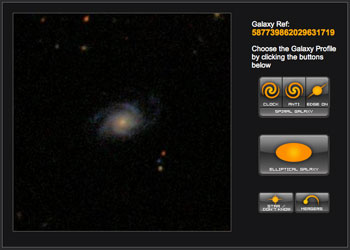What do you do when you have a lot of data and not enough personnel and time to analyze it? Well, you outsource it of course. In this case, though,
they're outsourcing it to us.
You're sitting on a pile of about a million telescopic photos of the universe, and each one needs to be classified. Bit of a job. So what do you do? Astronomers at the University of Portsmouth, Oxford University, and Johns Hopkins University came up with a solution last week that not only alleviated the burden but also generated an enthusiastic response from the public: They opened up the project to volunteers via the Internet.
The goal of the project is to identify and classify galaxies all over the universe and create a distribution map of galactic types--primarily spiral versus elliptical, but with some variations as well.
In order to accomplish this, the three universities opened up the project on a website called GalaxyZoo. Users log into the site, then are shown images of galaxies (and other cosmic entities). They then enter information about they images they see.
I sent this along to the science teacher at my school who teaches Astronomy - seems like a good project for the students in that class, don't you think? Now, if we could simply get our hands on that 142 megapixel camera they're using . . .


Hey Mr. Fisch. I was lucky enough to go to a conference in Minneapolis hosted by the World Future Society. It's been very educational and I think you may be interested in much of what the society does. I went to a few very fascinating workshops regarding the future of technology and education including things we haven't even considered before on this blog. You might want to look into it. The website is wfs.org.
ReplyDeleteHey Molly, that sounds really interesting. Do you think you have enough info that you could put something together to share with teachers (and would you be interested)? If so, let me know and we can figure it out.
ReplyDeleteSeparate from this, I really want to figure out a way to get students who are interested more involved in our staff development efforts. I know I said the same thing last year, but I want to figure out a way to make it meaningful for all involved.
I don't know if I could do a whole fancy presentation, but I may be able to think of something to do. Most of the really technological stuff was lost on me, but the workshops did mention a shift in how my generation's mind works and what is going to be needed in the workplace in 20 years. Although, I think that some of the stuff on this blog is probably better than some of their ideas. Not bad, eh? But surely we can think of something I can put together.
ReplyDeleteAlso, if you want to get a few students, put out the word to a few of the main teachers on here. Surely if they mention something in their classes you can get some more students involved. And once there are students in the circle, maybe they could just drop in on a few of the 21c meetings. Most students probably wouldn't mind giving up a little time if they realize that they can get their voices heard.
Hey Karl,
ReplyDeleteSomeone has started a game of tag online. I took the bait. You can read more about it (if you're in) on my blog at:
http://web.mac.com/seddonk/iWeb/e-cubed/tuesdays/B2DC093A-6758-4B68-B296-4A0C86C6E5E0.html
We shared your Did You Know? and 2020 Vision with at least 1000 teachers this summer in Florida. They loved it!
Karen
I am interested to see where this goes and am excited for what this could mean for our students in Hatak's Astronomy class. He had his students do a similar thing and how incredible to have it part of the "official" database.
ReplyDelete